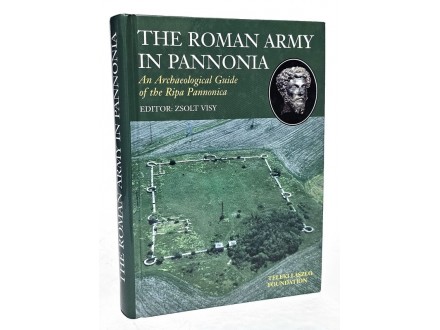The Roman Army in Pannonia - Visy Zsolt
| Cena: |
| Želi ovaj predmet: | 11 |
| Stanje: | Nekorišćen |
| Garancija: | Ne |
| Isporuka: | Pošta Lično preuzimanje |
| Plaćanje: | Tekući račun (pre slanja) Lično |
| Grad: |
Beograd-Mladenovac, Beograd-Mladenovac |
ISBN: Ostalo
Godina izdanja: 2003
Jezik: Engleski
Autor: Strani
An Archeological Guide of the Ripa Pannonica
Teleki László Foundation 2003 206 strana + XVI strana tabli + karte : ilustrovano
očuvanost 5
Antički Rim
The Roman Empire was one of the largest and longest-existing states in world history that has had a determining effect on the peoples now living in its former territory and, in many respects, on the culture of the whole world. By expanding as far as the Danube River, the Empire advanced from the Mediterranean into the migratory zone of the Eurasian peoples. Thus Rome entered into a series of conflicts with the Germanic, Iranian, and Turkish peoples massing along its borders, which, in the long run, contributed to her downfall. Rome`s frontier, the limes, or more properly called ripa being a frontier along a river, ran across the Carpathian Basin for 450 years and ensured the security of the Empire within its bounds of possibility. The forts, towers, and other military installations, as well as the nearby civil settlements have decayed through the centuries, but their ruins have survived, and the well-built military road served as a reasonably comfortable line of traffic for both soldiers and civilians until as late as the eighteenth century. These remains, together with the other European, African, and Asian sections of the Roman limes form an especially important element of the cultural heritage of mankind.
The earliest excavation and, interestingly, also the first conservation of an archaeological monument in Hungary took place in 1778, when István Schönwisner unearthed and provided a protective structure for a portion of the large military bath of the Óbuda legionary fortress. The systematic archaeological excavations and research began at the end of the nineteenth century and have continued since. Hungarian archaeology has achieved important results since then. The large-scale construction work that took place at a great number of sites in the second half of the twentieth century provided a special impulse to archaeological work. However, there are still only poorly investigated areas, especially along the southern section of the ripa in Hungary. The fact that the right to organise the 12th International Limes Congress was given to Hungary in 1976 was an acknowledgement of the achievements of the Hungarian research, in addition to the opportunity to host the numerous researchers from all around the world in Hungary during the 19th Congress in 2003.
Seven countries now share the area of Pannonia, and five of them have sections of the ripa Pannonica within their frontiers. This book resulted from the cooperation of an international group of archaeologists. It aims to give a description of the entire Pannonian frontier section, but the limited size of this volume does not allow for the inclusion of each and every military installation. Therefore, both the authors and the reader have to be satisfied with a selection of sites: the limes-forts and fortresses, the late Roman inner fortresses, a choice of smaller, but important military sites, and the limes-road. However, the general map shows all the known military installations. Aside from the sites inside the province, the volume also includes the bridgeheads, forts, and towers built on the left bank of the Danube, i.e., on barbarian territory.
The Roman limes can only be understood if the peoples living on its other side are brought into scope as well. One of the most important topics of the 19th Congress is the discussion of the Roman-barbarian relations. This explains why this volume deals in detail with a selection of sites once inhabited by Sarmatians and Germans on the Great Plain, thus giving an insight into their life and funerary traditions, as well as dealing with the great Earthworks built on the Plain in the fourth century as a demarcation line.
Ne šaljem u inostranstvo!
Ne šaljem na Kosovo (tj. Pošta ne prima pošiljke za Kosovo).
Predmet: 74847441







